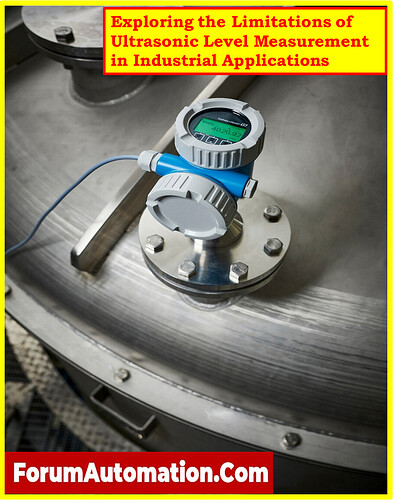- In numerous industrial applications, ultrasonic level measurement is a commonly utilized method for determining the level of liquid or solid materials.
- It has a lot of benefits, like non-contact measurement and simplicity of installation, but it also has a few drawbacks and limitations.
What are the limitations of ultrasonic level measurement?
The following are some drawbacks of using ultrasonic level measurement:
Limited Accuracy in Specific Situations:
- In conditions where humidity, pressure, or temperature are rapidly changing, ultrasonic level measurement may not be as accurate.
- These factors can have an effect on the speed of sound in air, which can then lead to inaccurate measurements.
Accuracy under Non-Ideal Conditions:
- When ultrasonic sensors are utilized with substances that are very absorbent, viscous, or dusty, the accuracy of the sensors’ readings can be affected.
- These circumstances may result in signal attenuation or reflection problems, which could lead to erroneous measurements.
Limited Range:
- Comparatively to various other level measurement technologies, ultrasonic sensors have a constrained measurement range.
- Depending on the design and capabilities of the sensor, they may struggle to deliver accurate measurements over either extremely short or very long distances.
Obstacle-related interference:
- Ultrasonic sensors produce sound waves that may be reflected by objects or buildings in the measurement path. The precision of the level measurement may be affected by these reflections, often referred to as echoes.
- To reduce this problem, it is crucial to set sensors correctly and eliminate impediments.
Multipath Interference:
- Multiple sound reflections can happen in surroundings with reflecting surfaces or uneven material surfaces.
- Signal interference and inaccurate measurements may result from this.
- To reduce multipath interference, specialized signal processing and sensor configuration may be necessary.
Limitations on the Applicability of Some Materials:
- Materials with irregular forms, such as powders or solids with uneven surfaces, may not be suitable for ultrasonic level measuring.
- In such situations, it’s possible that the sound waves can’t deliver readings that are accurate and constant.
Environmental and weather factors:
- Particularly when utilized outside, extreme weather conditions like snow, rain, or fog can have an impact on how well ultrasonic sensors operate.
- These circumstances may weaken or scatter the sound waves, resulting in inaccurate results.
Maintenance requirements:
- Regular maintenance is necessary to ensure the optimal operation of ultrasonic sensors.
- The performance and accuracy of the sensor can be impacted by dust, dirt, or moisture on its transducer. There might be a need for calibration and cleaning.
Cost:
- Although ultrasonic level sensors are typically regarded as being very cost-efficient, high-performance ones that include a variety of innovative features can sometimes be quite pricey.
- For some applications, the initial investment cost may be a drawback.
Consumption of Power:
- In order for ultrasonic sensors to function consistently, a constant supply of power is necessary.
- In situations where energy efficiency is important, this constant power usage may be a problem.
Limited Use for Gas Measurement:
- Liquid and solid materials are the main applications for ultrasonic level measurement.
- Due to the low density of gases, which may cause weak or unreliable reflections, it is not suitable for measuring gases.
Limitation of Resolution:
- When sensing slight level changes, ultrasonic sensors may have a low resolution.
- Their applicability for applications that call for accurate measurements may be impacted by this constraint.
Summary:
- While ultrasonic level measurement offers many advantages, including non-contact operation and ease of installation, it is essential to be aware of its limitations and disadvantages.
- Users should carefully assess the specific requirements of their applications and consider factors such as environmental conditions, material characteristics, and accuracy requirements when choosing a level measurement technology.
- In some cases, a different level measurement method, such as radar or guided wave radar, may be more suitable to overcome the limitations associated with ultrasonic sensors.
